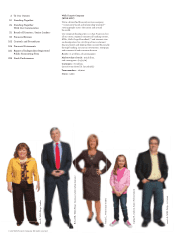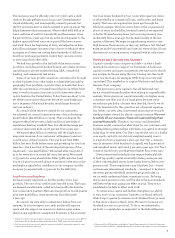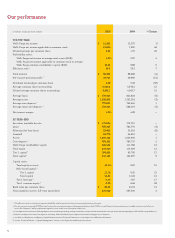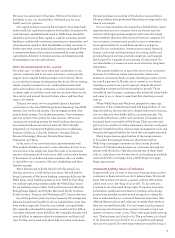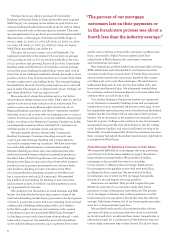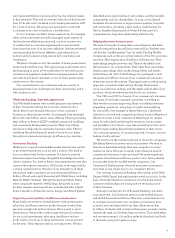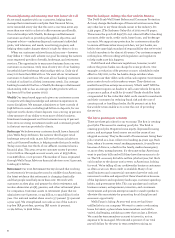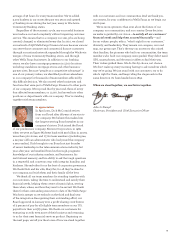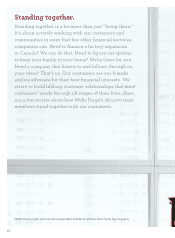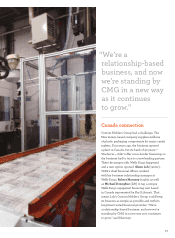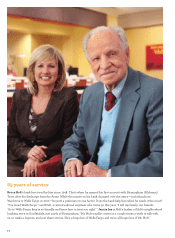Wells Fargo 2010 Annual Report Download - page 8
Download and view the complete annual report
Please find page 8 of the 2010 Wells Fargo annual report below. You can navigate through the pages in the report by either clicking on the pages listed below, or by using the keyword search tool below to find specific information within the annual report.
6
Thirteen years ago, when I was head of Community
Banking for Norwest Bank in Texas (before Norwest acquired
WellsFargo), our company set an ambitious goal to have our
average banking household have eight products with us. Many
analysts, focused only on the next quarter, yawned. That year,
we averaged nearly four products per retail banking household.
The next year, at the merger of Norwest and WellsFargo, it
was 3.2. 1999: 3.4. 2000: 3.7. 2001: 3.8. 2002: 4.2. 2003: 4.3. 2004:
4.6. 2005: 4.8. 2006: 5.2. 2007: 5.5. 2008: 5.7. 2009: our legacy
WellsFargo households, just under6.0.
This year, we crossed a major cross-sell threshold. Our
banking households in the western U.S. now have an average
of 6.14products with us. For our retail households in the east,
it’s 5.11products and growing. Across all 39 of our Community
Banking states and the District of Columbia, we now average
5.70products per banking household (5.47a yearago). One of
every four of our banking households already has eight or more
products with us. Four of every ten have six or more. Even when
we get to eight, we’re only halfway home. The average banking
household has about 16. I’m often asked why we set a cross-sell
goal of eight. The answer is, it rhymed with “great.” Perhaps our
new cheer should be: “Let’sgo again, forten!”
More sales don’t always bring better service, but better
service almost always brings more sales. That’s why our service
quality scores are an early indicator of our sales trends. Our
service scores are rising. Almost eight of every ten of our
Regional Banking customers said they’re “extremely satisfied”
with their recent call or visit with our banking stores or contact
centers. For the second year in a row, we ranked #1 among large
banks, according to the American Customer Satisfaction Index,
an independent measure of how satisfied U.S. customers are
with the quality of consumer goods andservices.
We grew market share in several other Community
Banking businesses. Consumer checking accounts rose
a net 7.5percent. Average checking and savings deposits
across the company were up 10 percent. We have more than
two-and-a-half million business customer relationships.
Business checking accounts rose a net 4.8 percent last year,
while store-based business solutions increased 22percent in
the West. Sales of WellsFargo Business Services® Packages
(business checking account and at least three other business
products) rose 42percent, purchased by two of every three
new business checking account customers in the West.
Our average Business Banking customer in the West now
has 4.04products with us (3.76a yearago). We extended
$14.9 billion of new lending (to existing or new borrowers,
and increases to lines of credit) to small businesses in 2010,
up 2.9 percent from last year.
We continue to be the nation’s #1 small business and SBA
lender. Our Auto Dealer Services team grew its share of the
used-vehicle lending market from 4.3percent in the first quarter
of 2009 to 5.4percent at year-end 2010, retaining its #1 national
ranking, and solidifying relationships with 11,000 dealers.
In the West, eight of every ten new customers who opened
a checking account also purchased WellsFargo Packages®
(achecking account and at least three other products) — with
sales rising 21percent. We ended the year with 18.3million
active online banking customers, up 10.3percent from a year
earlier, and 4.7million active mobile customers, up 88percent
from a year earlier. Global Finance ranked us the best
online bank in North America for consumers, corporate,
and institutionalcustomers.
New regulations prohibit banks from automatically covering
ATM withdrawals and everyday debit card transactions that
customers make from accounts short of funds. They now must
choose if they want those transactions denied at the counter
or if they want us to cover those shortages. We want them to
make smart financial choices, use our free online tools, and
have a personal financial plan. We eliminated overdraft fees
for consumer and most business deposit customers when they
overdraw their account by $5 orless.
Our student lending in the private market rose 43 percent
in our Wachovia community banking states and our national
market share rose to 25 percent (16 percent a year ago). A new
law regrettably removed private-sector lenders from the federal
student market, but there’s still an important role for private
lenders. We’re very much in the student loan business, as we’ve
been for 42years. College costs continue to rise. Government-
guaranteed loans provide only about $7,500 or less for college
costs. Students, families, and schools still need our help to be
financially successful, especially Wachovia customers, because
their company had exited the student loan business right before
it merged with WellsFargo.
Home Mortgage: Helping keep customers in their homes
We originated $386 billion in mortgages this year, providing
one of every four home loans making us, again, the nation’s
largest home mortgage lender. We provided 1.8 million
mortgages, at historically low rates, for customers
to buy a home or refinance their mortgage. Applications
for mortgages in the pipeline at year-end were $73 billion,
up 28 percent from a year ago. We serviced $1.8 trillion
in mortgages, one of every six U.S. mortgage households,
the nation’s second-largest servicing portfolio.
Americans are resilient. They proved it again this year.
Ninety-two percent of our customers made their home
payments on time. Delinquency rates declined. The percent
of our mortgage customers late on their payments or in the
foreclosure process was about a fourth less than the industry
average. Only three of every 100 of our home equity customers
were two or more payments past due.
We avoided foreclosure for about three-fourths of those
customers 60 days or more past due who chose to work with
us. In 2009 and 2010, we adjusted loan terms, lowered rates or
reduced principal (or a combination of the three) for 620,000
loans to help customers stay in their homes. For 73,000 loans,
“The percent of our mortgage
customers late on their payments or
in the foreclosure process was about a
fourth less than the industry average.”


